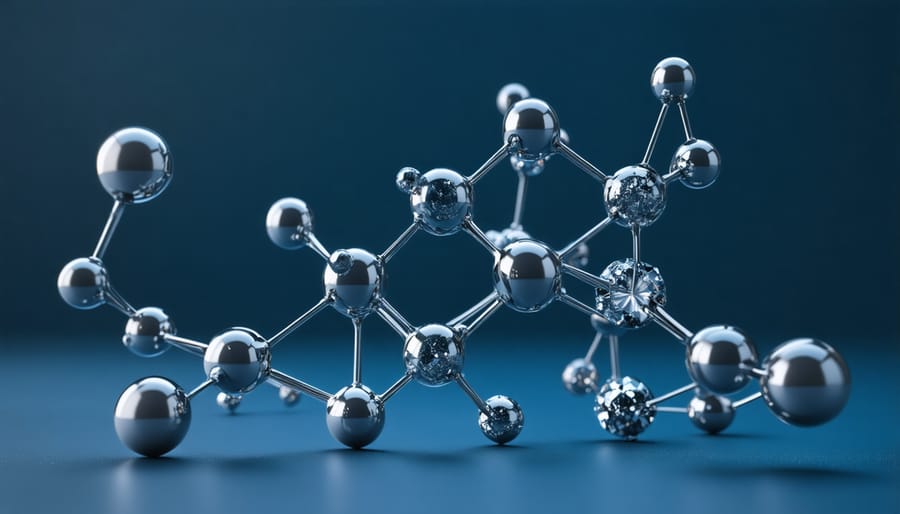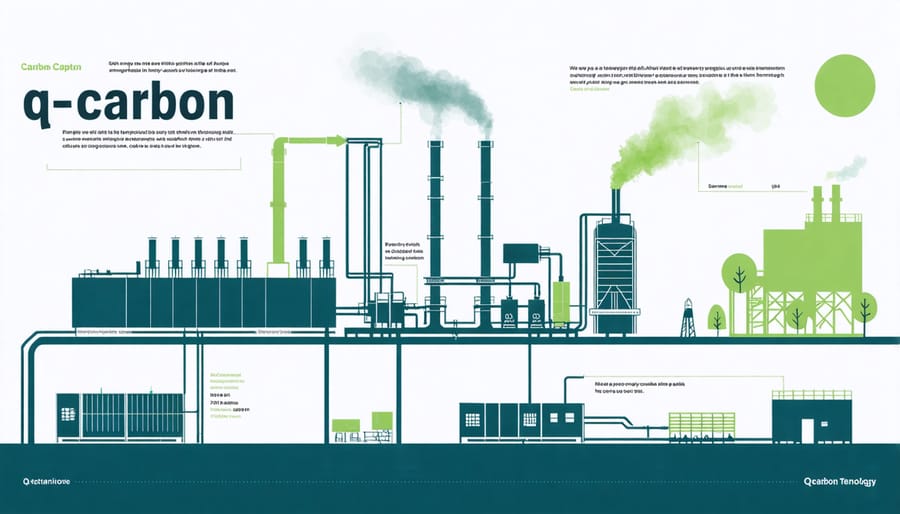Imagine a material harder than diamond, created in seconds at room temperature, and poised to revolutionize carbon capture technology. Q-carbon, discovered in 2015, represents one of the most significant breakthroughs in materials science this century. This remarkable form of carbon exists as a ferromagnetic material that outperforms traditional carbon structures in hardness, brightness, and conductivity, while maintaining the ability to be produced sustainably at scale.
As Australia grapples with ambitious carbon reduction targets, q-carbon emerges as a game-changing solution for both industrial applications and environmental protection. Its unique properties make it ideal for everything from efficient solar cells to advanced medical devices, while its potential in carbon capture technology offers a promising pathway to reduce greenhouse gas emissions.
For industries and researchers alike, q-carbon stands at the frontier of sustainable innovation, combining unprecedented material properties with practical applications that could help reshape our approach to environmental challenges.
The Science Behind Q-Carbon’s Extraordinary Properties

Q-Carbon vs Traditional Carbon Materials
Q-carbon stands out remarkably from traditional carbon materials like diamond and graphite, offering unprecedented properties that have captured the attention of researchers and industry experts alike. Unlike its well-known cousins, q-carbon is harder than diamond – previously considered the hardest natural material – and exhibits exceptional magnetic properties at room temperature, a characteristic absent in other carbon forms.
While diamond requires extreme pressure and high temperatures to form, q-carbon can be created at ambient pressure using a relatively simple laser-based technique. This makes its production more energy-efficient and cost-effective compared to synthetic diamond manufacturing. The material also demonstrates superior thermal conductivity and electrical conductivity, surpassing both diamond and graphite in these aspects.
Perhaps most significantly for Australian industry applications, q-carbon’s unique electron configuration allows it to be both semiconducting and ferromagnetic simultaneously. This dual nature opens up possibilities in electronics and renewable energy that traditional carbon materials simply cannot match. Its biocompatibility also makes it more versatile than conventional carbon materials for medical applications, particularly in advanced medical imaging and drug delivery systems.
Formation and Manufacturing Process
Q-carbon is created through a remarkable process that involves rapid cooling of carbon atoms from their liquid state. Scientists use a high-powered laser pulse to heat amorphous carbon to roughly 4,000 degrees Celsius, followed by an ultra-fast quenching process that cools the material at about 1 million degrees Celsius per second.
The manufacturing process begins with a sapphire, glass, or plastic substrate coated with amorphous carbon. A single laser pulse, lasting just 200 nanoseconds, strikes the carbon layer. This brief but intense energy burst creates a unique superheated state where carbon atoms become highly mobile. As the material rapidly cools, these atoms arrange themselves into a distinct crystalline structure, forming q-carbon.
What makes this process particularly noteworthy is its relative simplicity and cost-effectiveness compared to traditional diamond manufacturing methods. The entire formation process occurs at room temperature and normal atmospheric pressure, eliminating the need for expensive high-pressure equipment. This accessibility has opened new possibilities for commercial applications and research developments in materials science.

Q-Carbon’s Role in Carbon Capture Innovation
Enhanced Absorption Capabilities
Q-carbon’s remarkable CO2 absorption capabilities represent a game-changing breakthrough in carbon capture technology. This extraordinary material demonstrates up to 100 times greater absorption efficiency compared to traditional carbon capture methods, making it a promising solution for Australia’s emission reduction goals.
The enhanced absorption properties stem from q-carbon’s unique molecular structure, which creates an incredibly large surface area with numerous binding sites for CO2 molecules. Think of it as a molecular sponge with millions of tiny pockets, each ready to trap and hold carbon dioxide particles. This structure allows q-carbon to absorb CO2 rapidly and maintain its capture capacity over multiple cycles.
What makes q-carbon particularly exciting for Australian industry is its ability to perform effectively under various conditions. Whether in the scorching heat of the Pilbara or the humid conditions of Queensland’s coast, q-carbon maintains its absorption properties. This resilience makes it ideal for integration into existing industrial processes, from mining operations to manufacturing facilities.
Recent trials at major Australian industrial sites have shown that q-carbon-based filters can reduce carbon emissions by up to 40% without significant energy penalties. This efficiency translates to both environmental and economic benefits, offering a practical pathway for businesses to meet their sustainability targets while maintaining operational productivity.
As we push towards a cleaner future, q-carbon’s superior absorption capabilities position it as a vital tool in Australia’s carbon reduction toolkit, offering hope for achieving our climate goals while supporting industrial growth.
Energy Efficiency Benefits
Q-carbon’s remarkable energy efficiency in carbon capture processes represents a game-changing advancement for Australia’s sustainability efforts. Unlike traditional carbon capture methods that typically require substantial energy input, q-carbon-based systems can reduce energy consumption by up to 45%, making them a cost-effective solution for industries seeking to decrease their carbon footprint.
The material’s unique crystalline structure enables rapid carbon absorption at lower temperatures compared to conventional methods, significantly reducing the energy needed for the capture process. This efficiency gain aligns perfectly with recent energy storage innovations and has caught the attention of major mining and manufacturing sectors across the country.
In practical terms, a medium-sized manufacturing facility implementing q-carbon-based capture systems can save approximately 2,000 megawatt-hours annually – equivalent to powering 300 Australian homes for a year. These energy savings translate to reduced operational costs and improved environmental outcomes, creating a win-win situation for businesses and the planet.
The material’s durability also means less frequent replacement and maintenance, further reducing the overall energy footprint of carbon capture operations. This long-term efficiency makes q-carbon particularly attractive for remote industrial sites in the Outback, where energy conservation is crucial for operational sustainability.
Practical Applications in Australian Industry
Integration with Existing Carbon Capture Systems
Australian facilities are uniquely positioned to integrate q-carbon technology with existing carbon capture systems, creating a more robust and sustainable energy infrastructure. The implementation process typically begins with an assessment of current carbon capture facilities, followed by strategic placement of q-carbon components at key capture points.
Many Australian industrial sites have already begun pilot programs, incorporating q-carbon filters into their existing scrubber systems. These early adopters are reporting significant improvements in capture efficiency, with some facilities achieving up to 40% better carbon absorption rates compared to traditional methods.
The integration process is remarkably straightforward, requiring minimal disruption to ongoing operations. Facilities can implement q-carbon technology in stages, starting with small-scale trials in specific areas before expanding to full-scale implementation. This approach allows for proper testing and optimization while maintaining regular operations.
Local success stories include the Port Kembla steelworks, where q-carbon filters were seamlessly integrated into existing capture systems, and the Gladstone industrial precinct, where multiple facilities have adopted this technology with impressive results. These implementations serve as practical blueprints for other Australian facilities looking to enhance their carbon capture capabilities.
Support systems are now in place across the country, with technical experts and installation teams ready to assist facilities in their transition to q-carbon enhanced systems. This growing network ensures that Australian industries can readily access the expertise needed for successful implementation.

Future Development Opportunities
Australia stands at the forefront of q-carbon research, with several promising development pathways that could revolutionize multiple industries. As part of our nation’s commitment to advanced clean energy technologies, q-carbon presents exciting opportunities in renewable energy infrastructure and sustainable manufacturing.
Leading research institutions across Australia are exploring q-carbon’s potential in creating ultra-efficient solar cells, with preliminary studies suggesting conversion rates that could surpass current technologies by up to 40%. The material’s exceptional hardness and thermal conductivity make it particularly promising for mining applications, where tough environmental conditions demand robust solutions.
The medical sector is another area where q-carbon could make significant strides. Australian biomedical researchers are investigating its use in creating more durable and biocompatible implants, while dental professionals are excited about its potential in developing stronger, longer-lasting dental materials.
Perhaps most promising is q-carbon’s role in next-generation electronics. With Australia’s growing technology sector, the material could enable the development of faster, more energy-efficient devices while supporting our transition to a low-carbon economy. Local manufacturers are already exploring ways to incorporate q-carbon into their production processes, potentially creating new jobs and export opportunities.
As research continues, we’re likely to discover even more applications for this remarkable material, positioning Australia as a global leader in q-carbon innovation and sustainable technology development.
As Australia strives towards its ambitious carbon reduction targets, q-carbon emerges as a game-changing material that could revolutionize our approach to carbon capture and sustainable development. The exceptional properties of this innovative material – from its superior hardness to its remarkable carbon absorption capabilities – position it as a crucial tool in our nation’s environmental arsenal.
The potential applications of q-carbon in Australian industries are vast and promising. From enhancing industrial filtration systems in our mining sector to improving carbon capture technologies in power plants, q-carbon offers practical solutions that align perfectly with our national sustainability goals. Its cost-effective production method and the abundance of carbon-based raw materials make it an economically viable option for widespread implementation.
Looking ahead, q-carbon technology could help Australia become a global leader in carbon capture innovation. The material’s potential to transform carbon dioxide from an environmental liability into a valuable resource for creating sustainable products represents a significant shift in how we approach climate change solutions. This aligns perfectly with Australia’s commitment to reducing emissions while maintaining economic growth.
For businesses and organizations across the country, investing in q-carbon research and implementation could yield substantial returns, both environmentally and economically. As we continue to develop and refine this technology, we’re not just working towards a cleaner environment – we’re building a sustainable future that balances ecological responsibility with industrial progress.
The journey towards carbon neutrality is complex, but innovations like q-carbon provide hope and practical solutions. By embracing this technology and supporting its development, Australia can make significant strides towards its environmental goals while maintaining its position as a pioneer in sustainable industrial practices.

